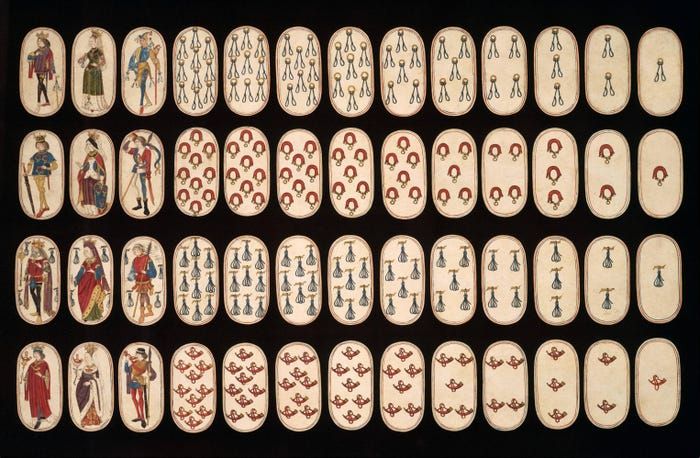 The World’s Oldest Full Deck of Playing Cards Was Almost Lost to History
The World’s Oldest Full Deck of Playing Cards Was Almost Lost to History
Megan Willett-Wei, Jan 26, 2015, BusinessInsider.com
In 1983, The Metropolitan Museum of Art bought a 52-card deck of South Netherlandish playing cards. The cards dated from the 15th century and were in incredible condition — but they were almost lost to history. An Amsterdam antiques dealer was sold the pack back in the ‘70s for $2,800. They were said to be a “unique” pack of tarot cards from the “16th century,” according to the Paris auction house that sold them. But the dealer who bought the deck was skeptical, according to a The Day article published in 1983. He thought they might be even older.
After five years of research, he was able to successfully date the cards to between 1465 and 1480 thanks to the style of the paintings, watermarks on the pasteboard, as well as the costumes and hairdos worn by the Burgundian court figures on the cards. The shoes, hairstyles, and clothing worn by the kings and queens were going out of style by 1480. The watermarks were also common in Southern Flanders and the Netherlands from 1466 to 1479, according to The Day. The dates were confirmed by the Central Laboratory for Objects of Art and Science in Amsterdam which dated the paints used to the 15th Century. 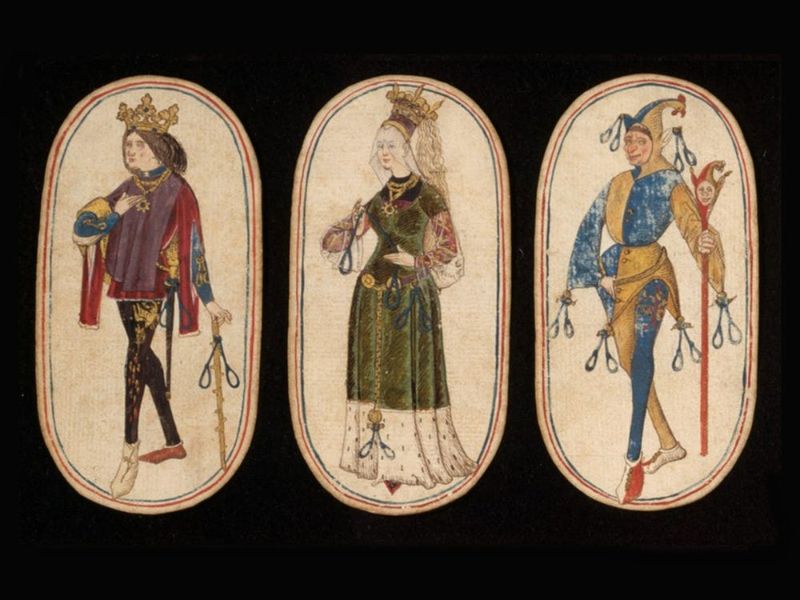
All of this digging and research paid off. In 1983, the Met bought the pack for $143,000.It is now accepted that this is the oldest known full deck of playing cards in the world. The cards themselves are also very interesting. Instead of the suits we know today, the four-card categories are based on hunting gear, including hunting horns, dog collars, hound tethers, and game nooses. This was not uncommon given that many countries had their own suit symbols. 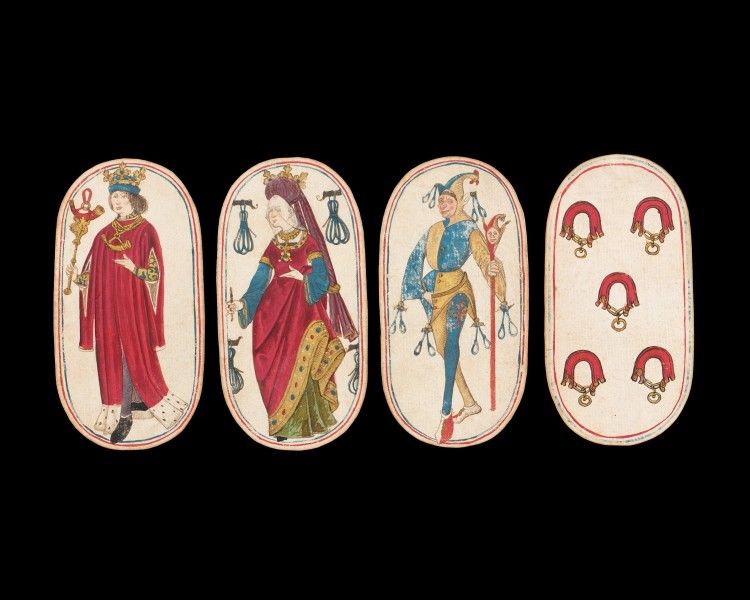
Playing cards were introduced to Europe through the Mameluke Empire in Egypt after originating in China. The Mameluke suits were goblets, gold coins, swords, and polo sticks. Italy and Spain transformed them into batons/staves, swords, cups, and coins. German card makers had acorns, leaves, hearts, and bells. The French were the ones to simplify the shapes and make them the clover, "pike-heads" (a type of weapon), hearts, and paving tiles. The English used the simplified French shapes but called the pike-heads "spades" and the paving tiles "diamonds."Mass-producing and printing playing cards had still not become the norm, so these cards were drawn free-hand with pen and ink with gold and silver later applied. Because they are in such good condition, it’s assumed the cards were rarely touched. You can currently view the cards at The Met's Cloisters museum in New York City.
Reference:
https://www.businessinsider.com/worlds-oldest-full-deck-of-playing-cards-2015-1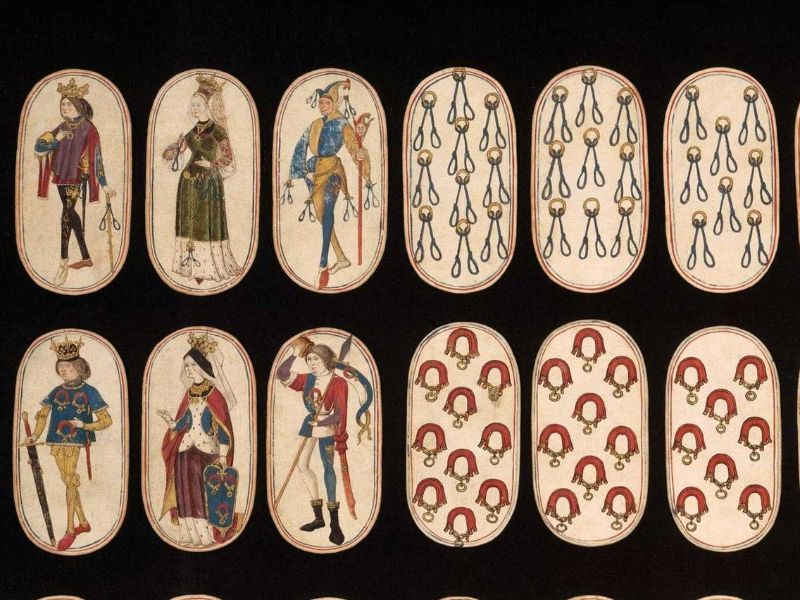
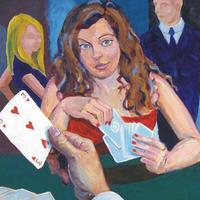
sweetwonk
 Oxford
Oxford
World’s Oldest Playing Cards
Hollywood Gin
HOLLYWOOD GIN...The game of the stars
Historic Card Games by David Parlett
One of the reasons why the history of Gin Rummy remains tantalizingly obscure is that it didn't really come into its own until the 1930s, for as late as the 1926 edition of Official Rules of Card Games it was still being recorded under its older title Poker Gin or Gin Poker. One circumstance that helped it was the Depression when more and more people had less and less to spend on going out and enjoying themselves and had to rediscover the art of amusing themselves at home. Gin was much simpler to learn than Contract Bridge and more congenial in the family circle than Poker.
But perhaps what really helped it on its way was its popularity with actors, stars, and the celebrity-seeking riff-raff of Broadway and Hollywood, and the consequent publicity the game attracted to itself. Hardly a film of that period fails to mention it somewhere, or at least get it on screen. Even Flora Robson as Elizabeth I and Errol Flynn as the Earl of Essex appear to be playing it - though, unfortunately, not mentioning it - in The Sea Hawk (1940). Dale Armstrong reports:
"On one occasion, in a desperate effort at rescue, the [Burbank Lakeside Country] club's House Committee was forced to persuade rotund comedian Oliver Hardy (of Laurel and Hardy fame) to stay out of the card room, where the Gin sharks had been eating him alive for months, to the tune of four figures a week."
Two features of the game made it attractive to those hanging about in the wings waiting for their cue, or in the studio waiting for the greens man to revive the pot plants. One was that it was very fast to play but could, if necessary be left off at a moment's notice and easily picked up again as soon as the players were free. The other was the introduction of an ingenious scoring device - the so-called "Hollywood Gin" variety - whereby you could (in effect) play three games simultaneously, or even an endless series of them.
To say that Gin became a craze of that period would be to put it almost literally. Here's an account of it from the pen of Damon Runyon, who wrote an enormous number of humorous short stories set in and around Broadway and involving just about the craziest characters ever created.
"The cards in Gin-Rummy run hot and cold the same as the dice in a crap game. It is by no means necessary to go to Harvard to learn to play Gin and in fact, a moron is apt to play it better than Einstein. If you get the tickets in Gin you are a genius, and if you do not get them you are a bum. When they do not come you can only sit and suffer and the aggravation of waiting on cards that never arrive will give you stomach ulcers in no time.
Nearly everybody in the United States of America plays Gin-Rummy. The little children in the street play it. Old broads play it. I understand there is a trained ape in the Bronx Zoo that plays it very nicely and I am not surprised, because I can teach any dumb animal to play Gin-Rummy if I can get it to hold ten cards."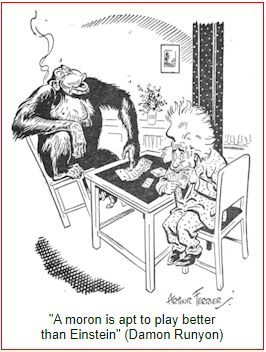
Reference:
This article was copied from Historic Card Games by David Parlett
https://www.parlettgames.uk/histocs/ginrummy.html scroll to 6th section on that page
Stu Ungar ... possibly the best gin rummy player in the world
Stu Ungar – possibly the best gin rummy player in the world and a World Series of Poker champion. 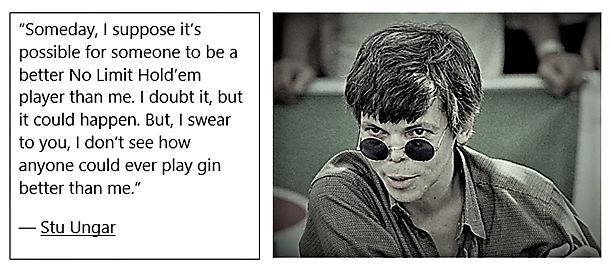
Stuart Errol Ungar (September 8, 1953 – November 22, 1998) was born and raised in Manhattan, New York in a Jewish family. Stu learned card games as a child while hanging around at his father’s club, Foxes Corner. His father, Isidore ("Ido") Ungar, was a bookmaker and loan shark and was opposed to young Stu playing cards, after seeing the effects of gambling on his regular customers. Somehow Stu managed to begin playing gin rummy underground. Stu won his first gin rummy tournament at the age of 10. Stu was making a name for himself in the game was when he was still in primary school.
When Stu was 14, his father died suddenly, and soon after his mother had a stroke and needed a lot of help at home. Stu had to drop out of school. He started playing gin rummy full-time to support his family. In his late teens, Stu became friends with organized crime figure Victor Romano. Victor was regarded as one of the best card players of his time. Victor shared an interest in calculating odds while gambling as Stu did. The two developed a close relationship, with Victor serving as a mentor and protector.
Stu began winning tournaments quite regularly, making $10,000 or more at a time. By 1976, still in his early 20s, Stu had already become one of the best-known rummy players in New York. Stu later moved to Miami searching for more rummy action. Unfortunately, his skill and reputation as the top rummy player made his opponents wary, so they started refusing games with him for fear of losing! Stu moved on to Las Vegas hoping to find more games. However, after having defeated the best gin rummy players of his generation, he had become well-known as an unbeatable player. Since the sight of him drove away potential players casinos asked him not to enter their establishments.
This drying up of opportunities for rummy forced Stu to take up poker. In Vegas, he defeated Billy Baxter, a professional gambler, for $40,000. Stu entered the World Series of Poker in 1980 and won-becoming the youngest player in history to do so. Stu defended his title successfully in the 1981 World Series of Poker. After his win in 1997, Stu would become one of only 2 players in the world to win the World Series of Poker 3 times.
Stu went through a divorce and struggled with cocaine addiction. By 1997, he was in debt and his health had declined due to drug abuse. His friend Billy Baxter helped arrange his $10,000 by-in to allow him to play in the 1997 World Series of Poker won the title once more, and the media dubbed him ‘The Comeback Kid’, due to the 16 years gap between his previous victory in 1981.
Stu died of heart problems a year later, in 1998, at age 45. Despite having won an estimated $30 million during his poker career, he died with no assets to his name.
reference: https://en.wikipedia.org/wiki/Stu_Ungar
~~~~~~~~~~~~~~~~~~~~~~~~~~~~~~~~~~~~~~~
also read:
Fishman, Steve. (1999). The End of the Game. New York Magazine online. Retrieved 8/7/2021 from: https://nymag.com/nymetro/news/people/features/914/
quote from the article:
"Tiny Stuey Ungar of the Lower East Side was born to a bookie; grew up with gangsters; and, in Manhattan’s illicit gambling clubs, became “the Mozart of the card table.”


